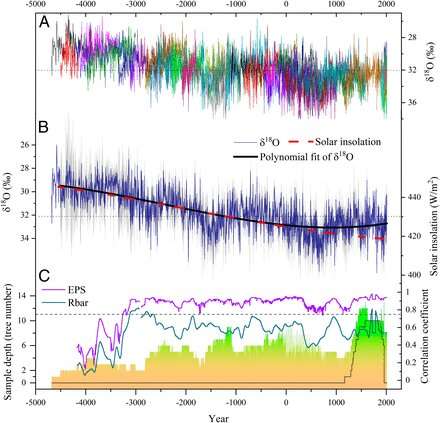he DLH tree-ring δ18O chronology. (A) Visualization of all 44 δ18O measurement series. (B) DLH δ18O chronology (navy blue line), third-order polynomial fitting of this chronology (thick black line), and July solar insolation between 30°N and 60°N (red line). The gray shading indicates the 95% CI of the composite δ18O chronology. For better comparison, the y-axis of the δ18O chronology was reversed. (C) Sample depth (with the black line indicating the number of trees in the pooled series) of the DLH δ18O chronology and Rbar (gray line) and EPS (purple line) of the δ18O dataset, calculated over a 250-y window in steps of 1 y. The Rbar time series was smoothed with a 100-y Gaussian-weighted filter. The annual values with EPS ≥ 0.85 accounts for 80.2% during 3250 BCE to 2011 CE, whereas 91.2% of values have EPS ≥ 0.25 and 37.7% are ≥ 0.50 before 3250 BCE.
Chinese researchers along with international colleagues recently reported a 6,700-year-long, precisely dated and well-calibrated tree-ring stable isotope chronology from the Northeastern Tibetan Plateau. It reveals full-frequency precipitation variability in the Asian Summer Monsoon (ASM) from interannual to multimillennial timescales with a long-term decreasing trend and several abrupt climate change events.
The international research team comprised 20 scientists from research groups based in China, Norway, Germany, United Kingdom, U.S., Sweden, Canada, and Switzerland and was jointly led by Prof. Nils Chr. Stenseth from the University of Oslo and Prof. Yang Bao from the Northwest Institute of Eco-Environment and Resources of the Chinese Academy of Sciences. The team studied more than 9,500 individual oxygen isotope measurements from juniper tree rings to reconstruct ASM variability over the past 6,700 years.
The researchers extracted and analyzed the oxygen isotopes from each ring in each tree independently, enabling them to build the most detailed dataset ever for the period from the mid-Holocene to the present.
These tree-ring stable isotopes offer a far more accurate archive for reconstructing full-frequency precipitation variability in North China than conventional tree-ring studies, which often fail.
By comparing this ASM precipitation reconstruction with another tree-ring oxygen record from the Animaqing Mountains, the researchers inferred that during the mid-Holocene, the ASM limit extended at least 300 km further northwest compared to its present day limit.
This allows direct comparison between the ASM's northern boundary 5,000 years ago and in the current era.
This precipitation reconstruction also provides a valuable opportunity to determine the societal and ecological responses to rapid climatic change in the past.
The reconstruction suggests that a rapid decrease in moisture availability from ~2,000–1,500 BCE caused a drought regime from ~1,675–1,185 BCE, which might have played an important role in regional forest deterioration and enhanced aeolian activity during that time.
In addition, the data also suggest that abrupt aridification starting about 2,000 BCE might have contributed to the shift of Neolithic cultures in northern China and likely triggered human migration and societal transformation during that time.
The results were published in PNAS in an article titled "Long-term decrease in Asian monsoon rainfall and abrupt climate change events over the past 6,700 years."
More information: Bao Yang et al, Long-term decrease in Asian monsoon rainfall and abrupt climate change events over the past 6,700 years, Proceedings of the National Academy of Sciences (2021). DOI: 10.1073/pnas.2102007118
Journal information: Proceedings of the National Academy of Sciences
Provided by Chinese Academy of Sciences
























